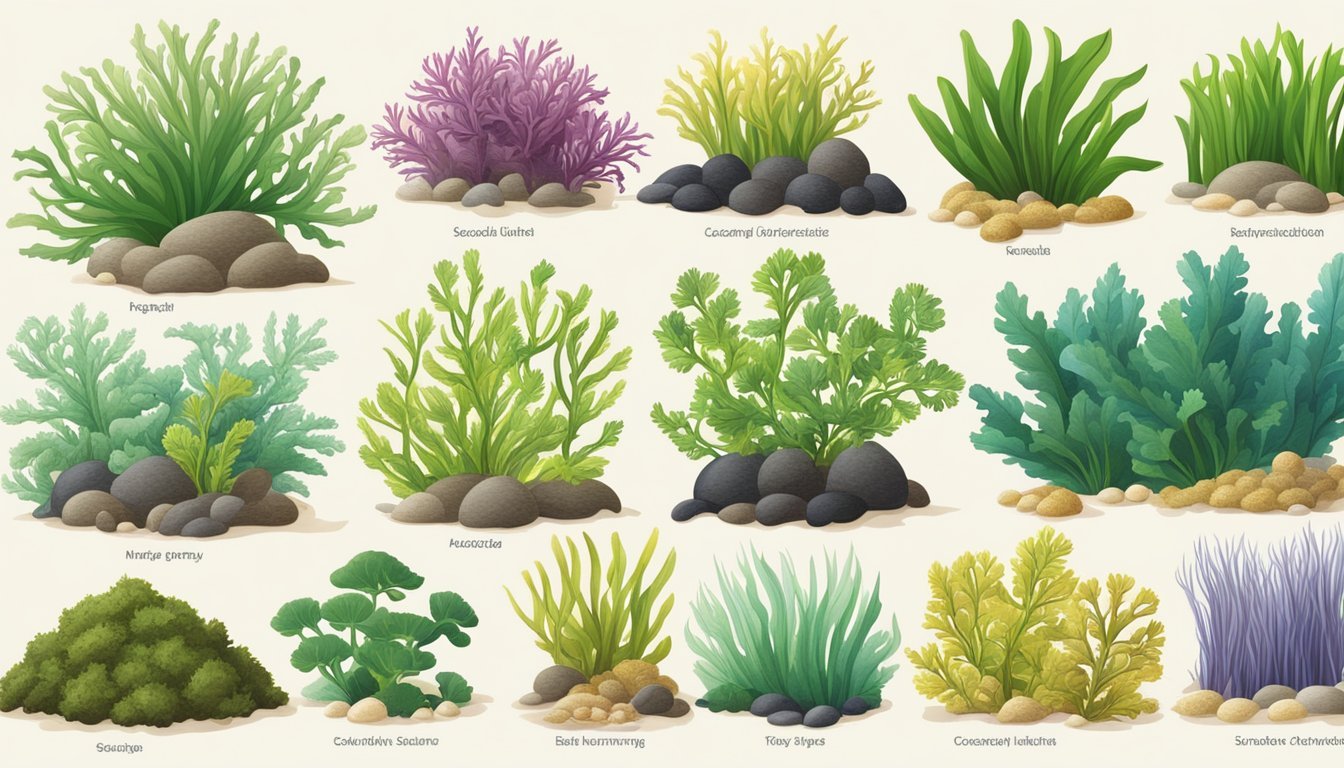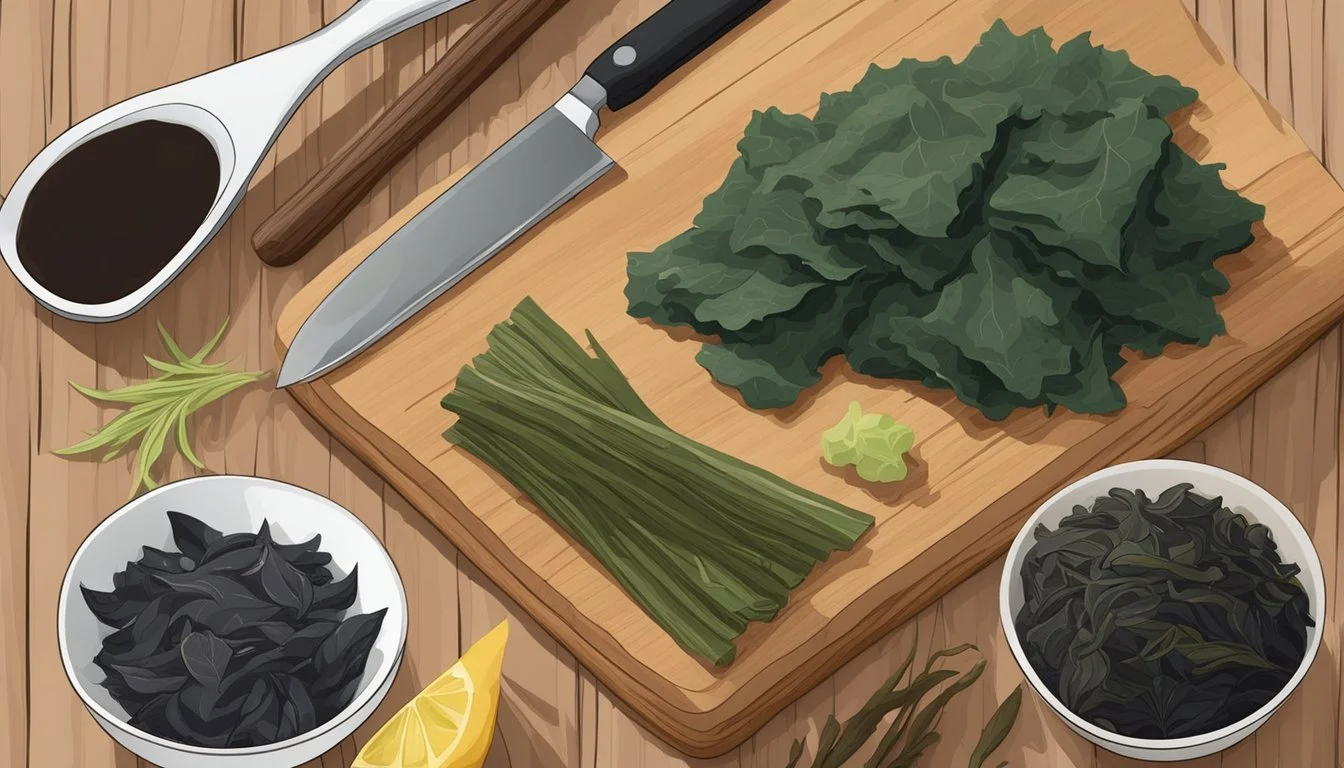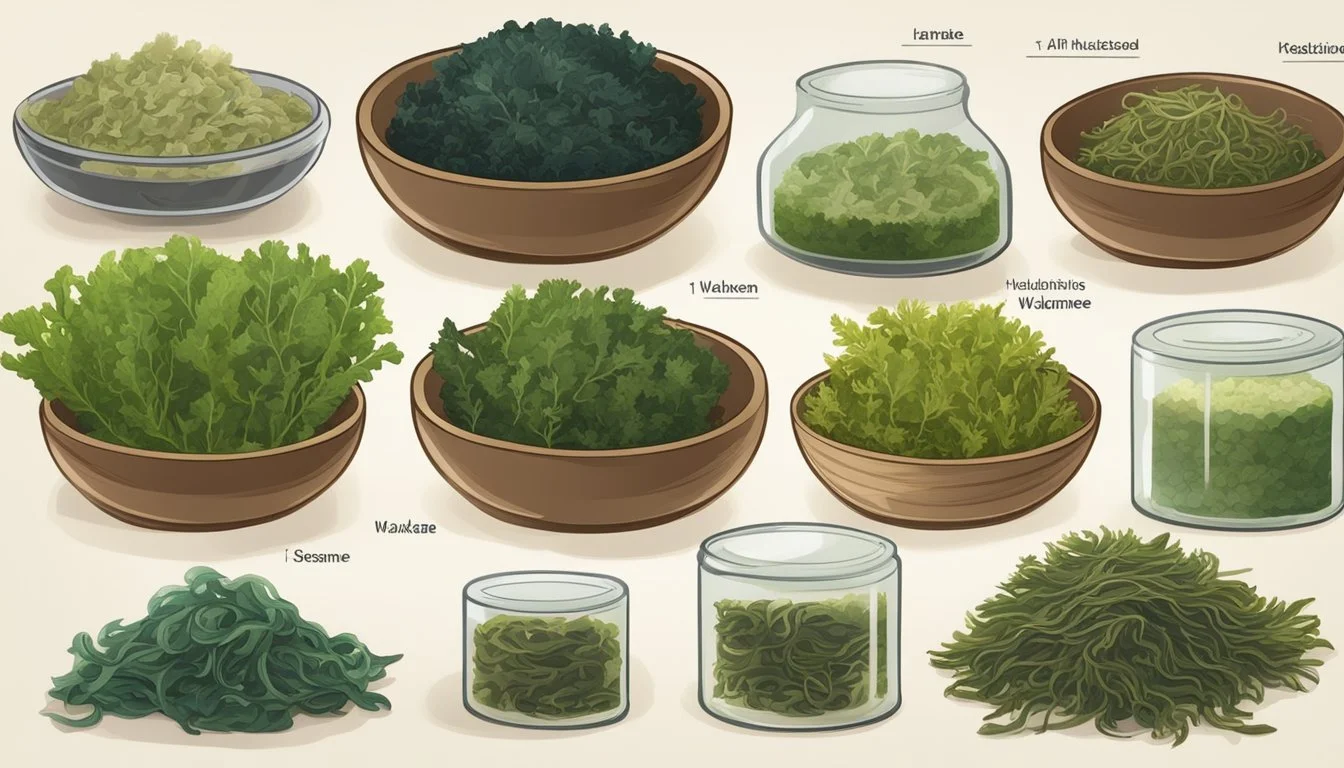Wakame Substitutes
Top Alternatives for Your Recipes
For those exploring Japanese cuisine, Wakame is a versatile seaweed that enriches dishes with its unique texture and nutritional benefits. When Wakame is unavailable, equally effective substitutes like kombu and dulse can be used to maintain the flavor and health benefits in your recipes. Kombu, another type of kelp commonly used in dashi, offers a similar umami profile, making it an excellent alternative in soups and broths.
Dulse, a red seaweed with a chewy texture and savory taste, can replace Wakame in salads and stir-fries. Its distinctive flavor can even mimic certain qualities of bacon, adding a unique twist to your dishes. For those who prefer plant-based options or have dietary restrictions, rice sheets soaked in water can also serve as a suitable substitute in various recipes.
Incorporating these alternatives into your cooking ensures that you don't miss out on the benefits that seaweeds bring. Maintaining your recipe's nutritional value and distinctive taste is crucial, and these substitutes provide a practical solution, ensuring your culinary creations remain both healthy and delicious.
Understanding Wakame
Wakame seaweed, a staple in Japanese cuisine, is known for its rich umami flavor and nutritional benefits. It is typically sold dried and can be easily rehydrated for various culinary applications.
Characteristics of Wakame
Wakame is a type of seaweed with a leafy texture, more flat and broad rather than stringy. When dried, it has a dark green appearance, which turns deep green upon rehydration. The rehydration process is simple; it involves soaking the dried Wakame in water for about 10 minutes until it becomes tender. The soaked seaweed has a mildly sweet and salty flavor, adding a unique umami taste to dishes. Easily incorporated into many recipes, its versatility is one of its key characteristics.
Culinary Uses of Wakame
Wakame is highly valued in culinary traditions, especially in Japan. It is often used in soups like miso soup, adding depth and texture. Salads frequently feature rehydrated Wakame for its nutritious boost and appealing texture. It can also be incorporated into stir-fries and rice dishes, providing an extra layer of flavor. The slightly briny taste of Wakame pairs well with various vegetables and proteins, making it a versatile ingredient in both traditional and modern recipes.
Nutritional Benefits of Wakame
Wakame is celebrated not just for its flavor but also for its nutritional profile. It is rich in vitamins such as A, C, D, E, and K, which are essential for various bodily functions. Minerals like iodine, calcium, and magnesium are present in significant amounts, promoting thyroid health and bone strength. Additionally, Wakame is low in calories while being high in protein and fiber, making it an excellent addition to a balanced diet. Its nutritional properties help support overall health and wellness.
Using Wakame in meals can enhance both the nutritional value and taste, making it a valuable ingredient for health-conscious consumers.
Ideal Substitutes for Wakame
Replacing Wakame in dishes requires knowledge of suitable alternatives that bring similar flavor and texture. Options like Kombu, different ingredients for soups and broths, and salad-friendly substitutes ensure that your meals remain delicious and authentic.
Kombu as Substitute
Kombu, another type of seaweed, is an excellent alternative to Wakame. It is widely used in Japanese cuisine, especially for making the savory Dashi broth. Kombu has a robust umami flavor that can enhance the taste of soups, stews, and broths.
To use Kombu, soak it in water to rehydrate, then incorporate it into your dish. Its texture is slightly tougher than Wakame, making it ideal for slow-cooking applications. Kombu also contains beneficial minerals, adding a nutritional boost to your recipes.
Substitutes in Soup and Broths
For those looking to substitute Wakame in soups and broths, Hijiki and Arame are good options. Hijiki provides a rich, earthy flavor and has a slightly chewy texture. It works well in Miso Soup and Tofu Soup, enriching the overall taste.
Arame, on the other hand, is milder and more delicate. It's flexible enough to be added to various broths without overpowering other flavors. Both these seaweeds can be rehydrated and used similarly to Wakame, ensuring your soups maintain their desired consistency and taste.
Salad-Friendly Substitutes
Sea lettuce is a green seaweed that serves as a great substitute for Wakame in salads. It has a delicate, grassy flavor that adds freshness to any dish. Sea lettuce's tender texture makes it easy to mix with other salad ingredients without overwhelming them.
Another option is Nori flakes, usually used for sushi rolls but equally excellent for sprinkling over salads. Nori brings a subtle marine flavor and a slightly crispy texture when toasted. These substitutes help maintain the balance of flavors and textures in your salads, offering a delightful eating experience.
Other Seaweed Varieties as Alternatives
For those seeking versatile alternatives to wakame, options like nori, hijiki, and dulse offer distinct flavors and textures suitable for various dishes.
Nori for Umami
Nori provides a rich umami flavor that can enhance soups, salads, and sushi. This seaweed is commonly found in sheet form, often used to wrap sushi rolls.
Shredded nori can be sprinkled over salads or rice bowls for an added depth of flavor. Its mild, slightly salty taste makes it a flexible substitute comparable to wakame in many recipes. Nori's umami characteristics are a testament to its popularity in Japanese cuisine, where it contributes significantly to the savory profile of dishes.
Hijiki's Distinctive Texture
Hijiki is notable for its chewy texture and earthy flavor, making it an excellent addition to dishes needing substance. Unlike the softer texture of wakame, hijiki retains a firmer bite, which can add an interesting dimension to salads and stir-fries.
Typically sold in dried form, hijiki should be soaked before cooking to rehydrate it. This seaweed pairs well with both light and hearty ingredients, offering versatility. Its distinctive texture complements grains like rice or quinoa, enhancing the dining experience with a pleasant, chewy mouthfeel.
Dulse: The Sweet Substitute
Dulse is known for its sweet, salty flavor profile, which can be used to add a unique taste to various dishes. Available in both whole leaf and powdered forms, dulse can be used similarly to wakame in soups, stews, or as a seasoning.
Crisping dulse in a pan transforms it into a flavorful snack or a crunchy topping for salads and sandwiches. The natural sweetness of dulse balances well with savory or tangy ingredients, providing a versatile alternative for those looking to replicate or diversify the flavor of wakame in their cooking.
Non-Seaweed Substitutes
When looking for non-seaweed substitutes for Wakame, there are several land-based ingredients that can effectively mimic the texture and sometimes the flavor profile. Shiitake mushrooms, tofu, and various green vegetables are excellent options to explore.
Shiitake Mushrooms: A Land-Based Option
Dried Shiitake Mushrooms are a standout substitute due to their robust umami flavor, which can mimic the savory qualities of Wakame. Rehydrated shiitake mushrooms provide a similar texture to seaweed, making them an ideal addition to soups, broths, and salads.
To use, simply soak dried shiitake mushrooms in warm water until soft, then slice them thinly. They pair well with vegan and vegetarian dishes, adding a depth of flavor without the need for seaweed.
Tofu: Versatility in Use
Tofu offers incredible versatility and can be used in almost any dish where Wakame might feature. It absorbs flavors well, making it a suitable substitute in soups, stir-fries, and salads.
For best results, consider using firm tofu and marinate it in soy sauce or miso to infuse it with a savory taste. This substitute works particularly well in vegetarian and vegan recipes, providing both protein and texture.
Green Vegetables as Alternatives
Green vegetables such as lettuce, spinach, and kale can mimic the texture and freshness of Wakame in many dishes. While they do not offer the same umami punch, they are excellent for adding color and nutrients.
Lettuce, for example, can be used in cold salads or wraps to provide crunch. Spinach and kale can be lightly blanched and added to soups and broths, offering a slightly different, yet refreshing taste. These options are great for those following a vegan or vegetarian diet, ensuring a healthy and sustainable substitute.
Each of these substitutes brings its unique strengths to the table, allowing for a flexible and diverse culinary experience without relying on seaweed.
Substitutes Beyond the Kitchen
Using Wakame and other seaweeds like kombu outside the kitchen offers numerous health benefits, such as promoting skin health, supporting weight loss, and providing essential nutrients.
Kombu in Health and Beauty
Kombu, a type of kelp, is rich in minerals and antioxidants that are beneficial for skin health. It contains alginate, which helps to detoxify the skin by removing heavy metals and toxins. Many skincare products use kombu for its moisturizing and anti-aging properties.
Kombu is also found in Umami Tea, which promotes hydration and cellular repair. This tea, rich in iodine and fucoidan, supports thyroid health and offers calming effects, making it a popular choice in holistic beauty routines.
Wakame's Role in Diet and Weight Loss
Wakame is low in calories yet packed with nutrients, making it ideal for weight loss and a healthy diet. Its high content of fucoxanthin, a compound found in brown seaweed, has been linked to promoting fat burning.
Wakame is also rich in dietary fiber, which aids in digestion and provides a feeling of fullness, helping to reduce overall calorie intake. Including wakame in meals can therefore be an effective strategy for weight management and improving gut health.
Enhancing Flavors with Substitutes
Substituting wakame in dishes is not just about replicating its texture; it's about enhancing the flavors with the right ingredients to achieve a harmonious umami taste. Leveraging ingredients like miso, soy sauce, bonito, and katsuobushi can elevate your cooking.
Miso and Soy Sauce: Conveying Umami
Miso and soy sauce are essential in delivering umami, the fifth taste that adds depth and richness to dishes. Miso paste, made from fermented soybeans, can add complexity to soups and broths. It is particularly effective in miso soup, where it mimics the hearty flavor of wakame.
Soy sauce, a staple in many Asian kitchens, provides a salty and savory profile. It can be used in stir-fries, marinades, and dressings. The combination of miso and soy sauce ensures that the umami presence is robust, making them excellent substitutes for wakame in flavor-enhancing capacities.
Seasoning with Bonito and Katsuobushi
Bonito flakes and katsuobushi are integral in Japanese cuisine for achieving an umami boost. These dried, fermented, and smoked skipjack tuna shavings dissolve readily in broths and dashi, delivering a punch of savory flavor.
Bonito flakes can be sprinkled on top of dishes for a subtle smoky note, or they can be simmered in water to create a base for soups. Katsuobushi can replace wakame in fish stock due to its rich, oceanic flavor. Combining these elements with MSG or Ajinomoto can further amplify the umami taste, resulting in a deliciously enhanced flavor profile for any recipe.
Understanding Substitute Availability
Different substitutes for wakame vary in their accessibility and availability in global and local markets. This section explores both the global presence of alternatives and the ease of finding them in supermarkets.
Global Accessibility of Wakame Alternatives
Alternatives to wakame, such as kombu and dulse, are widely used in many parts of the world. Kombu, for instance, is a staple in Japanese cuisine and is often found in Asian supermarkets globally.
Dulse, another popular substitute, is available in health food stores and through online retailers. This red seaweed is not only used in Asian dishes but also in Western cuisine. Rice sheets are another option, commonly found in Thai and Vietnamese cooking, making them easy to obtain in regions with diverse Asian communities.
The ability to source these substitutes depends heavily on local culinary practices and market demand. For instance, kombu might be more accessible in countries with a prominent Japanese culinary influence, while dulse could be more readily found in areas with a focus on dietary health trends.
Finding Substitutes in Supermarkets
Supermarkets' inventory can vary significantly based on location and customer base. Major urban areas with diverse populations are likely to stock a variety of seaweeds, such as wakame, kombu, and dulse.
Asian supermarkets are excellent places to look for these alternatives. They frequently carry an array of seaweed products, including bulk packages and smaller, ready-to-use options. In contrast, mainstream supermarkets might have a more limited selection, often relegated to the international food aisle.
Health food stores also present a reliable option for finding seaweed varieties. These stores cater to those interested in nutritious and unique food items, making dulse and similar products relatively easy to find. For more niche items like rice sheets, specialty stores and online marketplaces provide convenient access for consumers.
Conclusion
When selecting a substitute for Wakame, consider the versatility and flavor profile of each alternative.
Kombu:
Common in Japanese cuisine.
Frequently used to make dashi broth.
Dulse:
A red seaweed found in health food stores.
Adds a slightly salty taste and crisp texture when cooked.
Rice Sheets:
Used in Thai and Vietnamese dishes.
Simple to prepare by soaking in water.
Each substitute offers unique flavors and textures, making them suitable for various dishes. Choose based on the specific culinary needs of your recipe.










